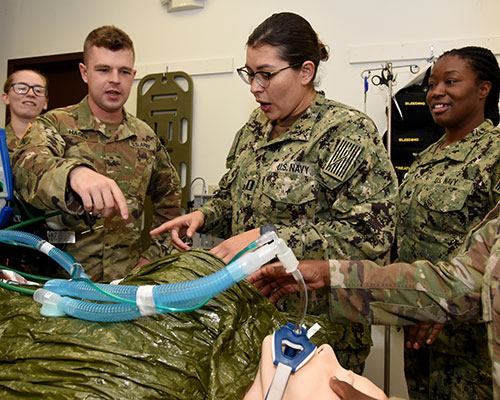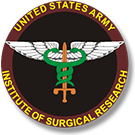USAISR Burn Center earns prestigious ABA
re-verification, Burn Fellowship verification

The U.S. Army Institute of Surgical Research Burn Center at Joint Base San Antonio-Fort Sam Houston, Texas, recently completed a successful American Burn Association (ABA) verification renewal visit. The ABA team recommended reverification of the only U.S. Department of Defense Burn Center without any deficiencies and submitted for approval to the ABA Verification Review Committee which voted to verify the burn center.
"Achieving ABA verification is an indicator that the USAISR Burn Center meets or exceeds the highest standards of care for burn injured patients as set forth by the national community of burn experts," said Maj. (Dr.) Garrett Britton, an Army internist who specializes in critical care medicine at the Burn Intensive Care Unit. "Verification as an ABA Burn Center is an indicator of quality. Earning verification indicates that the staff from each department across the burn center dedicates time and effort into providing utmost quality care."
The rigorous reverification process occurs every three years and starts a year prior to the burn center's verification expiration. It culminates with a two day on-site visit where the ABA team ultimately determines whether or not to recommend reverification. Six months before the on-site visit, an extensive pre-review questionnaire (PQR) is submitted to the ABA consisting of quality metrics from each department and category required for verification.
Tanya Luckado, burn program manager, has overseen the verification process for the past two cycles and says that being verified doesn't require much preparation, because it is a true testament to the quality of care given from the time of injury through rehabilitation, what we do every day.
"The surveyors [on-site team] look at the overall processes, the performance improvement or PI indicators and how we identify them, to the loop closure–how we have addressed the PI," she said. "So when asked how we prepare for an ABA verification visit, the answer is we do it every day. Yes, the application and PRQ is completed before the visit, but it is the consistent promotion of quality, safe patient care that gets us there."
During this reverification cycle, the Burn Center also applied for and was later successfully verified as one of the first ABA-verified burn fellowship training programs.
"The certification as an ABA Burn Fellowship training program indicates that we meet or exceed a high standard to train burn surgeons to provide high-quality burn care," said Britton. "For years the USAISR has trained high quality burn surgeons consistent with U.S. Army standards, until now however, there has not been a recognized accreditation process. The function of accrediting a fellowship training program is to ensure, nationwide, burn surgeons receive education on evidence-based best practices to ensure provision of high-quality burn care."
The burn fellowship program verification process is similar in many ways to Burn Center verification, in that accreditation involves an extensive PRQ submission process followed by a two-day on-site visit.
"We must also satisfy 33 criteria over seven different domains, ensuring we maintain top quality faculty dedicated to teaching the next generation of burn surgeons, provide a comprehensive curriculum that encompasses the entire spectrum of care for burn injured patients from initial injury, management of critical illness to reintegration into society and ongoing rehabilitation both physically and emotionally," added Britton.
The Burn Center has maintained a formal burn fellowship program for more than 20 years but hasn't had accreditation until this year. The fellowship program trains one or two burn surgeons every year that provides an exposure to the full spectrum of burn care.
"We care for some of the most severely injured patients in the DoD and South Texas," Britton said. "Burn fellows receive tremendous exposure to current and advancing concepts in burn surgical care, critical care, rehabilitation, behavioral health, and primary care. Our fellowship stands out as we also incorporate critical care air transport training and a robust research, process improvement, and leadership curriculum into the fellows' training.
"Earning certification as an ABA verified Burn Fellowship indicates we have high quality faculty; a comprehensive curriculum and train top-notch burn surgeons who provide the highest standards of care."
The Burn Center was established in the U.S. in 1949 for battlefield casualties but has evolved throughout the years to serve as a regional burn center for South Texas and now treats both military and civilian burn patients. It has been at the epicenter of burn research since its inception. Each year, approximately 600 patients are treated at the Burn Center and hundreds more as outpatients in the burn clinic.













